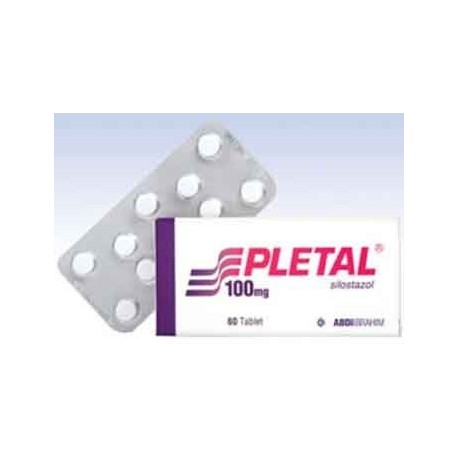 View larger
View larger Pletal (Cilostazol) 100 Mg 60 Tablets
PLTL3229
New product
BUY MORE PAY LESS
| Quantity | Discount | |
|---|---|---|
| 2 | 5% | |
| 3 | 10% | |
| 4 | 15% | |
| 5 | 20% |
Volume discounts
| Quantity | Discount | You Save |
|---|---|---|
| 2 | 5% | Up to $4.90 |
| 3 | 10% | Up to $14.70 |
| 4 | 15% | Up to $29.40 |
| 5 | 20% | Up to $49.00 |
More info
PLETAL 100 mg tablet Taken by mouth.
Active ingredient
Each tablet contains 100 mg cilostazol.
Excipients
Corn starch, microcrystalline cellulose, carmellose calcium, hydroxypropyl methylcellulose 2910 and magnesium stearate.
2.What is PLETAL and what is it used for?
PLETAL is an antithrombotic drug available in blister packs of 60 and 100 tablets.
Each PLETAL tablet contains 100 mg cilostazol as an active ingredient.
PLETAL;
Dilation of some of your blood vessels
Reducing the activity of cells that mediate coagulation, called platelets, in your veins.
It treats the circulatory disorder that causes cramp-like pain in your legs due to insufficient blood supply to your muscles.
It helps increase your pain-free walking distance.
3.How to use PLETAL?
Instructions for appropriate use and dose / frequency of administration
The usual dose in adults is 100 mg PLETAL tablet taken twice a day.
Daily doses should be taken half an hour before or 2 hours after breakfast and dinner.
Application route and method
The tablets are taken orally, swallowed with some liquid.
Use in children
Suitable for adults only.
Use in the elderly
There is no special dose application for the elderly.
Special use cases
Kidney / Liver failure:
In mild to moderate renal and mild hepatic insufficiency, the level of PLETAL in the blood was similar to healthy individuals. PLETAL should not be used in severe renal and moderate to severe hepatic impairment.
If you have an impression that the effect of PLETAL is too strong or too weak, talk to your doctor or pharmacist.
If you use more PLETAL than you should
If you have used more than you should use from PLETAL, talk to a doctor or pharmacist.
If you forgot to use PLETAL
Do not take a double dose to make up for forgotten doses.
Effects that may occur when treatment with PLETAL is terminated
When treatment with PLETAL is discontinued, it is possible that the pain in your legs will start again or worsen. Therefore, stop your treatment with PLETAL only when you notice side effects that require urgent medical attention or when your doctor recommends that you stop your treatment.
4. What are the possible side effects?
Like all medicines, people who are sensitive to the substances contained in PLETAL may have side effects.
If any of the following occur, stop using PLETAL and IMMEDIATELY inform your doctor or go to the nearest emergency department:
Difficulty in breathing, swelling of the face, lips, tongue or throat, sudden drop in blood pressure, widespread and severe rash, itching, hives (urticaria),
These are all very serious side effects.
If you have one of these, you have a serious allergy to PLETAL. You may need urgent medical attention or hospitalization. "
All of these very serious side effects are very rare.
If you notice any of the following, immediately report to your doctor or contact the emergency department of your nearest hospital:
Chest pain, palpitations, irregular heartbeat, low or high blood pressure, visual impairment, unstoppable bleeding.
All these are serious side effects. Immediate medical attention may be required.
Serious side effects are very rare.
If you notice any of the following, tell your doctor:
Very common (side effects affecting at least 1 in 10 people)
Headache
Abnormal stools
Diarrhea
Common (side effects affecting at least 1 in 100 people)
Rapid heart rate
Palpitation
Chest pain
Dizziness
Throat ache
Runny nose
Abdominal pain
Indigestion
Nausea, vomiting
Excessive gas extraction
Swelling of the ankles, feet, and face
Skin rash
Itching
Occasional bleeding in the skin
General weakness
Uncommon (side effects affecting at least 1 in 1000 people)
Difficulty carrying blood to the heart
Shortness of breath
Pneumonia
Cough
Cold
Unexpected bleeding
Tendency to bleed (stomach, eye or muscle, nosebleeds, urine or blood in saliva)
Decrease in red blood cells
Dizziness when standing
Feeling bad
Concern
Difficulty sleeping
Abnormal dreams
Allergy
pain
Diabetes or increased blood sugar
Abdominal pain
An increased risk of intraocular bleeding can be seen in people with diabetes.
Rare (side effects affecting at least 1 in 10,000 people)
Tendency to bleeding that lasts longer than usual
Increase in clotting cells in the blood
Kidney problems
Unknown side effects
Changes in blood pressure
Reduction in blood red, white and clotting cells
Difficulty breathing
Having trouble moving
Fire
Hot flushes and rash
Eczema and skin rash
Loss of sensation in the skin
Eye watering and stickiness
Tinnitus
Anorexia
Hepatitis or liver problems

